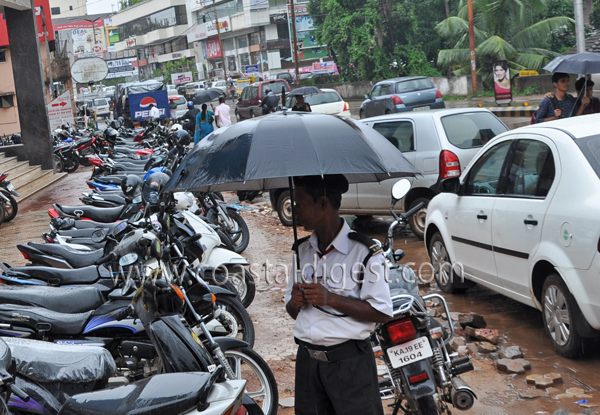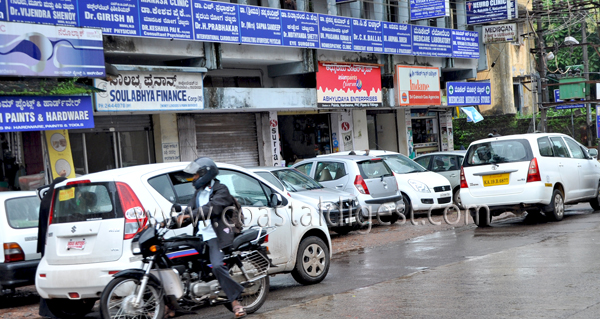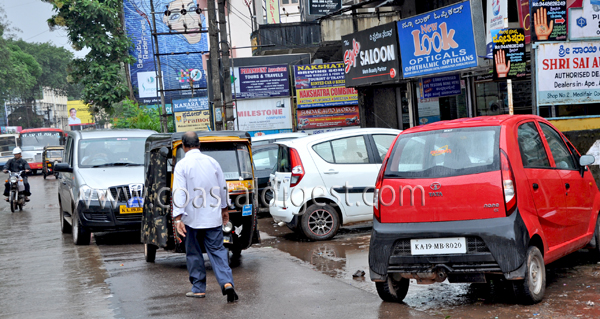
Even though the much-needed road widening and concretisation works have been successfully completed in many parts of Mangalore city long ago, the traffic flow continued to be affected thanks to the incompetency of the Traffic Police and increasing menace of illegal road-side parking and double parking near places of commercial activity.
The lack of civic sense among motorists, who tend to violate the traffic rules by parking their vehicles either on the footpath or on the road, has defeated very purpose of the road-widening.
Take for instance, the footpath in front of Bharat Mall in Bejai. The entire pavement is used as a stand for auto rickshaws and there’s no room left for pedestrians to walk on. Immediately adjacent to the auto stand on its right, the path has been dug up to 10 feet from the edge of the structure leaving no choice for pedestrians but to walk on the street. At the adjacent turn, the footpath is hardly existent and two-wheelers can be seen parked onto the road.
On the Bejai-Kavoor road after the turn, interlocks have only just been placed in position on the right-hand side of the road, but the path is more used for parking than to walk on. That portion of the street has not been allotted for parking purposes.
At the city bus stop opposite the KSRTC bus stand on Bejai Main Road, buses have resorted to pulling over on the road itself owing to the absence of a footpath. This leaves narrow room for vehicles to pass through at such times. Two and four-wheelers are also parked on the road, even though there is a ‘No Parking for 200 meters’ board put up a few meters away from the bus stop. Further down the road leading to Bejai Church, on the right-hand side, ample number of two wheelers have been parked right on the main road, leaving just a bit over half the width for vehicles to be traversed on. The buildings on the side reach up right to the edge of the street and there is no footpath. These buildings do not have provision of parking facility for its customers.
The Central Market area of the city is a different scene altogether. Maidan 1st Cross is a narrow one-way where parking has been allotted on alternate sides of the road on alternate days. If vehicles are to be parked disorderly (which they are sometimes), then passing through becomes trickier. The Market Road is a lane where two and four wheelers are parked haphazardly. Though parking for vehicles has been allotted only on one side of the road, local shop owners say that since lot of people visit the market every day, they park according to their own wish owing to the lack of parking spaces. An auto-rickshaw stand is seen on a lane where parking is not allowed. Not just autos but two and four wheeler vehicles are also seen parked there. “If the road gets congested, then we have to move or shift our autos to make way,” said an auto driver at the stand.
The same can be said of Car Street, where the widened road space has been used for parking, said social activist and president of Nagarika Hitha Rakshana Samithi Hanumantha Kamath. "The road here was widened to make it easier for the vehicles. The divider was not installed so that the Ratha of Venkateshwara Temple of Car Street could pass through. But, with the absence of one, motorists have taken to parking on both sides of the road. This defeats the very purpose of the widening. The amount of vehicles that can now traverse at a time on that stretch is less than that before the widening was done. Huge amount of money has been spent for the widening of the road. But, what purpose does it serve? Where should the people walk? It's as if the buildings have been demolished and road had been widened for the purpose of creating parking space,” he said.
The same problem can be seen on the road from Collector's gate to Bendoor. This is a ‘weakness’ of the district administration. The Traffic Police does not take any action. The Corporation has to install proper 'No Parking' signs wherever necessary and provide separate areas for parking facility, he said.
“If we ask the DCP (traffic), he says that there is lack of staff and hence they are unable to take any action,” laments Mr Kamath.
Further proof of illegal parking in the city can be seen on weekends, especially in the night. Both two-wheelers as well as four-wheelers are parked on the roads in front of the city’s various bars and pubs at night on Saturdays and Sundays. One such area is the pavement in front of Hotel Indra Bhavan in Balmatta.
When contacted, MCC Commissioner Dr. K Harish Kumar said that the Corporation had already intimated to the Traffic Police to clear illegal parking areas. "It is the jurisdiction of the Traffic Police," he said. When enquired about the proposed multi-level car parking facility, he said that Mangalore Urban Development Authority (MUDA) had taken initiative and added that they were trying their level best to get a client.
Assistant Commissioner of Police, Mangalore, G.V. Subramanya said that illegally parked vehicles were being fined Rs. 400 and vehicles parked for almost an entire day were towed away. A survey of all the areas in the city will be made in a couple of months, and illegal parking areas will be marked with ‘No Parking’ boards with the help of the corporators of respective jurisdiction, he said.







Comments
Add new comment